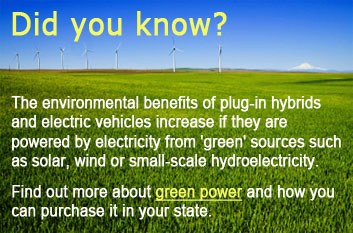Plug-in Hybrids

Plug-in hybrids, sometimes called Plug-in Hybrid-Electric Vehicles (PHEVs), are hybrids with high-capacity batteries that can be charged by plugging them into an electrical outlet or charging station. They can store enough electricity to significantly reduce their petroleum use under typical driving conditions.
Different Kinds of Plug-in Hybrids
There are two basic plug-in hybrid configurations:
-
Series plug-in hybrids, often referred to as Extended Range Electric Vehicles (EREVs). Only the electric motor turns the wheels. The gasoline engine only generates electricity. Series plug-ins can run solely on electricity until the battery runs down. The gasoline engine then generates electricity to power the electric motor. For short trips, these vehicles might use no gasoline at all.
-
Parallel or Blended Plug-in Hybrids. Both the engine and electric motor are connected to the wheels and propel the vehicle under most driving conditions. Electric-only operation usually occurs only at low speeds.
Some plug-in hybrids have higher-capacity batteries and can go further on electricity than others. PHEV fuel economy can be sensitive to driving style, driving conditions, and accessory use.
Benefits and Challenges

Less Petroleum Use. Plug-in hybrids use roughly 30% to 60% less petroleum than conventional vehicles. Since electricity is produced mostly from domestic resources, plug-in hybrids reduce oil dependence.
Less Greenhouse Gas Emissions. Plug-in hybrids typically emit less greenhouse gas than conventional vehicles. However, the amount generated depends partly on how the electricity is produced. For example, nuclear and hydroelectric plants are cleaner than coal-fired power plants.
Higher Vehicle Costs, Lower Fuel Costs. A plug-in hybrid can cost roughly $4 to $8 thousand more than a comparable non-plug-in hybrid. Using electricity is usually cheaper than using gasoline, sometimes much cheaper. However, fuel savings may or may not offset the higher vehicle cost. It depends on the vehicle, the share of miles operating on electricity, fuel costs, and ownership length. Federal tax incentives up to $7,500 are currently available for qualifying plug-ins.
Re-charging Takes Time. Re-charging using a 120-volt household outlet can take several hours. Re-charging using a 240-volt home or public charger can take about 1 to 4 hours. A "fast charge" to 80% capacity may take as little as 30 minutes. However, these vehicles don't have to be plugged in. They can be fueled solely with gasoline but will not achieve maximum range or fuel economy without charging.
Estimating Fuel Economy. Since a plug-in can operate on electricity alone, gasoline alone, or a mixture of the two, EPA provides a fuel economy estimate for gasoline-only operation and an estimate for electric-only or gas-and-electric operation—both for combined city-highway driving.
More Information
Hybrid and Plug-In Electric Vehicles
Benefits and Considerations of Electricity as a Vehicle Fuel
Maintenance and Safety of Hybrid and Plug-In Electric Vehicles


